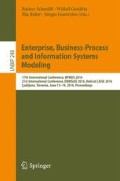Abstract
The purpose of business process diagrams is mainly to make the communication between process-related stakeholders more effective. Currently, BPMN (Business Process Model and Notation) is the leader and de-facto standard for business process modeling. However, the notation and their corresponding diagrams have been perceived as complex by many different researchers. Much work was already done in order to manage such complexity by changing or extending the existing BPMN notation. In this paper, we will propose a solution that aims to decrease the complexity of business process diagrams without changing the notation or existing approaches by introducing opacity-driven graphical highlights.
Access this chapter
Tax calculation will be finalised at checkout
Purchases are for personal use only
References
Moody, D.: The ‘physics’ of notations: toward a scientific basis for constructing visual notations in software engineering. IEEE Trans. Softw. Eng. 35(6), 756–779 (2009)
Gruhn, V., Laue, R.: Complexity metrics for business process models. In: 9th International Conference on Business Information Systems, BIS 2006, pp. 1–12 (2006)
Cardoso, J.: Approaches to compute workflow complexity. Business 06291, 16–21 (2006)
Decker, G., Puhlmann, F.: Extending BPMN for modeling complex choreographies. In: Meersman, R., Tari, Z. (eds.) OTM 2007, Part I. LNCS, vol. 4803, pp. 24–40. Springer, Heidelberg (2007)
Fernández, H.F., Palacios-González, E., García-Díaz, V., Pelayo G-Bustelo, B.C., Sanjuán Martínez, O., Cueva Lovelle, J.M.: SBPMN — an easier business process modeling notation for business users. Comput. Stand. Interfaces 32(1–2), 18–28 (2010)
Muehlen, Mz, Recker, J.: How much language is enough? Theoretical and practical use of the business process modeling notation. In: Bellahsène, Z., Léonard, M. (eds.) CAiSE 2008. LNCS, vol. 5074, pp. 465–479. Springer, Heidelberg (2008)
Kocbek, M., Jost, G., Hericko, M., Polancic, G.: Business process model and notation: the current state of affairs. Comput. Sci. Inf. Syst. 12(2), 509–539 (2015)
Object Management Group (OMG): Business process model and notation (BPMN) version 2.0. Business, vol. 50, p. 170 (2011)
Terry, M., Mynatt, E.D.: Enhancing general-purpose tools with multi-state previewing capabilities. Knowl.-Based Syst. 18(8), 415–425 (2005)
Cardoso, J.: How to measure the control-flow complexity of web process and workflows. In: Workflow Handbook, vol. 2005, pp. 199–212 (2005)
Edmonds, B.: What is Complexity - The philosophy of complexity per se with application to some examples in evolution, p. 13. Manchester Metropolitan University (1999)
Latva-Koivisto, A.M.: Finding a complexity measure for business process models. Complexity, pp. 1–26 (2001)
Dijkman, R., Dumas, M., García-Bañuelos, L.: Graph matching algorithms for business process model similarity search. In: Dayal, U., Eder, J., Koehler, J., Reijers, H.A. (eds.) BPM 2009. LNCS, vol. 5701, pp. 48–63. Springer, Heidelberg (2009)
Mendling, J., Reijers, H.A., Cardoso, J.: What makes process Smodels understandable? In: Alonso, G., Dadam, P., Rosemann, M. (eds.) BPM 2007. LNCS, vol. 4714, pp. 48–63. Springer, Heidelberg (2007)
La Rosa, M., ter Hofstede, A.H.M., Wohed, P., Reijers, H.A., Mendling, J., van der Aalst, W.M.P.: Managing process model complexity via concrete syntax modifications. IEEE Trans. Ind. Inform. 7(2), 255–265 (2011)
Erol, S.: Coloring support for process diagrams: a review of color theory and a prototypical implementation. Vienna University of Economics and Business (2015)
Dumas, M., La Rosa, M., Mendling, J., Reijers, H.A.: Fundamentals of Business Process Management. Springer, Heidelberg (2013)
Rolón, E., Ruiz, F., García, F., Piattini, M.: Applying Software metrics to evaluate business process models. CLEI Electron. J. 9, 15 (2006)
Author information
Authors and Affiliations
Corresponding author
Editor information
Editors and Affiliations
Rights and permissions
Copyright information
© 2016 Springer International Publishing Switzerland
About this paper
Cite this paper
Jošt, G., Polančič, G. (2016). Application of Business Process Diagrams’ Complexity Management Technique Based on Highlights. In: Schmidt, R., Guédria, W., Bider, I., Guerreiro, S. (eds) Enterprise, Business-Process and Information Systems Modeling. BPMDS EMMSAD 2016 2016. Lecture Notes in Business Information Processing, vol 248. Springer, Cham. https://doi.org/10.1007/978-3-319-39429-9_5
Download citation
DOI: https://doi.org/10.1007/978-3-319-39429-9_5
Published:
Publisher Name: Springer, Cham
Print ISBN: 978-3-319-39428-2
Online ISBN: 978-3-319-39429-9
eBook Packages: Business and ManagementBusiness and Management (R0)

